After leaving out one year, I was eager to ride across the Alps once again. I haven't yet counted all (paved) possibilities, but there are probably more than thirty all told. I had so far explored three of them: Through Chamonix via the Mont Blanc tunnel (by bus, you can't actually ride through - THEY WON'T LET YOU) into the Valle d'Aosta; further South via the Monte Cenisio and the Col du Galibier into the Haute Provence; and lastly, via the beautiful Col de la Lombarde just North of Nice. If there is a pattern, it's the absence of Austria. Perhaps out of respect, for here more than anywhere else along this magnificent mountain range, the Alps rise high along a central spine or main chain, almost uninterruptedly from West to East, posing a mighty, seemingly impenetrabel barrier. Deep valleys extend towards either side of that central chain, to the North into Austria, and to the South into Italy. One such valley is the Ötz valley, 60km long, forbiddingly narrow at times, and with punchy sections of climbing as you toil towards the tree line and then beyond. Sitting at just above 2500m, the Timmelsjoch pass marks the border to Italy, a pass considerably higher, and therefore much less travelled, than the neighbouring passes, the Brenner and the Reschenpass.
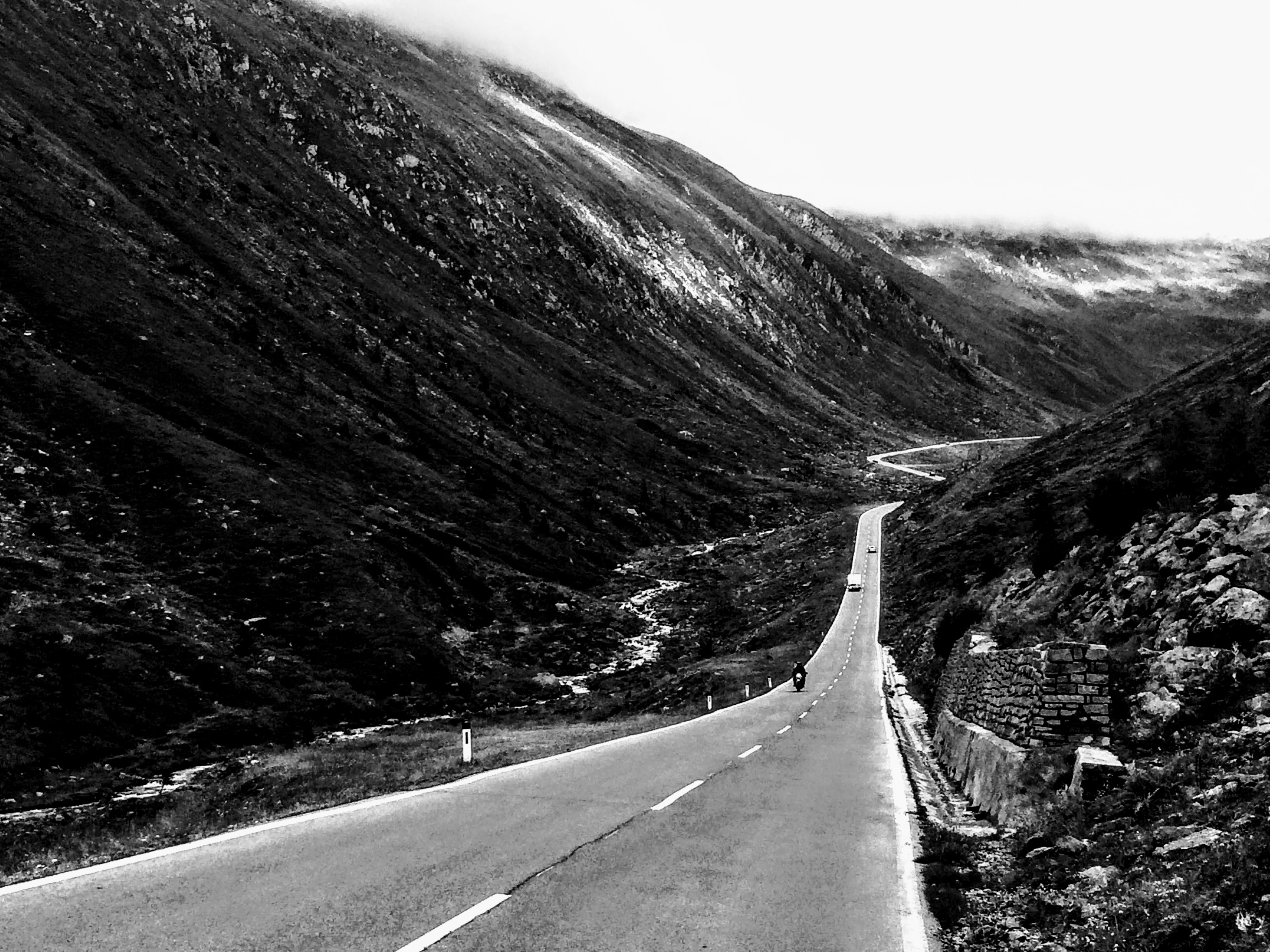
Climbing into the clouds. The final stretch towards the Timmelsjoch.
The trip was a short one, only five days with one rest day right in the middle. On the first I got myself into the Inn valley near Innsbruck via Kochel am See, and the second took me along the aforementioned Ötz Valley over the Timmelsjoch into beautiful Merano - the perfect place to have a rest day. The last two days were reserved for the return, and it was an exciting one.
There is one mountain pass just South of the main chain that for many cyclists holds a particular allure, and I was eager to put it squarely onto my home-bound itinerary. It's the Passo dello Stelvio, with 2757m the second highest paved pass in the Alps (the first being the Col d'Iseran beating the former by a mere 13m). To reach the bottom of the climb from Merano, one simply follows a bike path, almost continuously paved, into the Val Venosta (also known as the Vinschgau). It's only 50km, and though it climbs very gently, by the time you reach Prad am Stilfserjoch, which marks the beginning of the climb proper, you'll already have gained 500m. Coming fresh out of my rest day, the following 24km climb was not actually as hard as I had expected, or at least the last two thirds. As is often the case, the first part was the most difficult, mentally and physically. It always takes some time before you find a stable rhythm, before your body adjusts to the new normal. For the first time I notice the heat. Travelling at 40 km an hour along the valley floor, you generate a constant breeze that keeps you cool, but when you increase the power output and cut off the ventilation, the effect is massive. Psychologically, the first few kilometers can be hard because you know that you have only just begun, that all those 48 hairpins, in the case of the Stelvio, are still to come. Later, as you climb higher and higher, this propels you forward. It is as if shedding weight with every hairpin.
As I twist my way through the cooling forest, I begin to catch the occasional glimpse of the wilderness ahead. The glaciers of the mighty Ortler range soon come into view, and from then on, it's breathtaking vistas all the way to the top. Alpine scenery at its most spectacular.
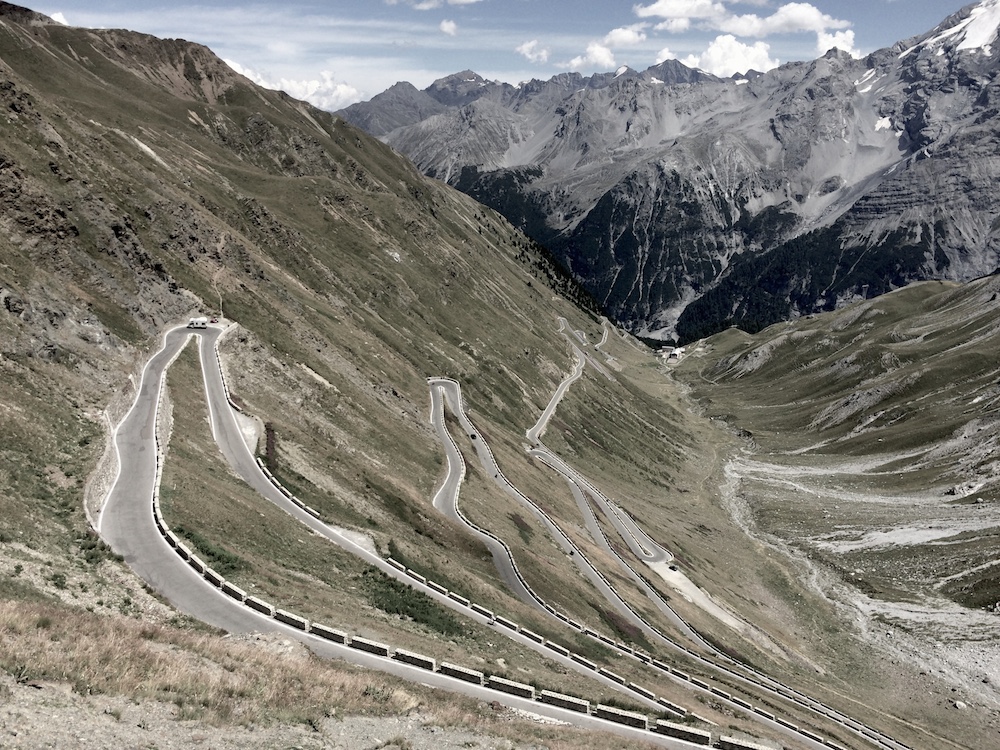
The famed Stelvio climb.
Soon after emerging from the trees, the road leads up into a side valley at the mouth of which sits a hotel with a restaurant, just shy of 2000m. It's a last opportunity to get some drinks and take stock of the last remaining 30 or so hairpins, for the view from here extends all the way to the Passo. The last stretch from then on was pure joy, so much so that I had to consciously hold back. When you feel good, it's tempting to spill all your beans and to empty yourself completely before you know it.
With that well-measured pace, I reached the top in fine fettle, got myself a plate of spagetti aioli, and descended, fully loaded and in good spirit, into Switzerland via the Passo de Umbrail, and from there back into the Val Venosta - whence I had begun the climb. The real challenge was yet to come, but little I knew. My objective for the day was to climb into the upper Inn valley via the Reschen Pass (Passo di Resia), another route to cross the main chain at moderate altitudes (just like the Brenner pass further East). There was even a dedicated path for bikers and hikers (the same I had taken in the morning). Except it would not follow the main road, which would zig-zag its way across the upper slopes of the valley, but would, rather unkindly, go right up - the shortest and steepest path out of the apple orchards of the Val Venosta, and clearly one meant to be cycled down (as many did) not up. The day's efforts were gradually taking their toll and I was struggling to find the right balance between digging deep, and staying within my limits. The Reschen Pass sits at only 1500m but it's exacting in its own ways. Most other pass roads go up, and then straight down again. Not this one. Just like on the Monte Cenisio, atop the pass sits a lake and it's another few rolling kilometers till the other end. By now the thunderstorms that had been forecasted for today were gathering all around me, and I had barely enough time to descend on the other side and find myself a place for the night before the rain began.
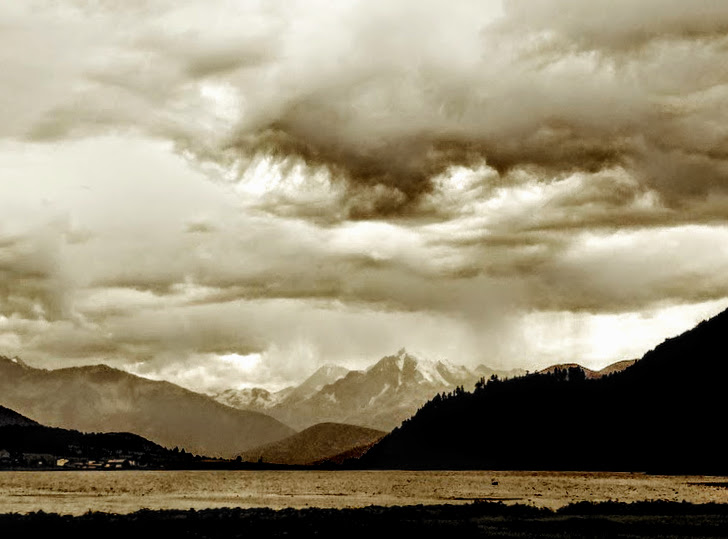
The Reschen pass, at last, and the weather getting worse by the minute. View back towards the Ortler Range, already hit by the first thunderstorms.
The final stage took me back to Munich via Landeck, the Fernpass, around the Zugspitze, then through Garmisch and past the Starnberg Lake. With 220km it turned out to be the longest stage, but also one with only moderate climbing. A fast, and very hot, finale to this short and scenic late August excursion through the Tyrolean Alps.
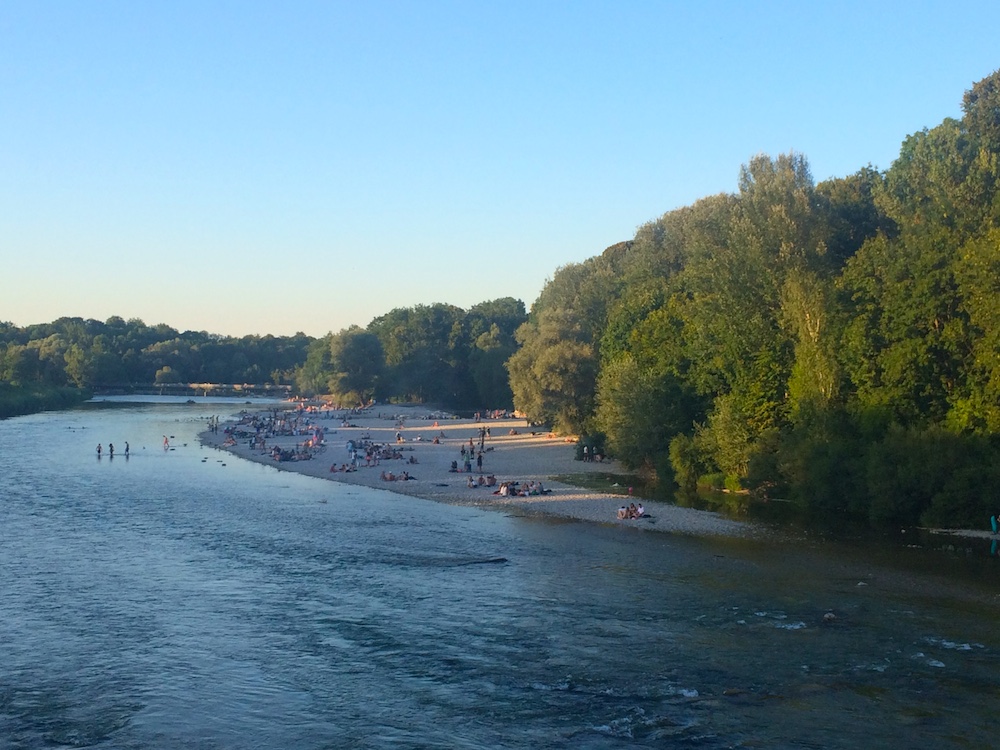
Another perfectly legitimate way to spend the day. Arrival in Munich after more than 200km. And yes, the water was absolutely amazing.
As always on such trips, I try to vary a few things, to eat or ride differently, or to use different or simply fewer pieces of equipment. This time I tried not drinking any sugary drinks, only pure water occasionally diluted with apple juice whenever I got some in one of the bars. Instead of going all out on carbohydrates, I took with me a jar of cashewnut cream. This is mostly unsaturated fats (> 40%), a fair amount of long-chain carbohydrates (25%), 5% naturally occuring sugars and with 20% a whole lot of protein, and no additives whatsoever. It's delicious on its own. I must have burnt through hundreds of kilos of this magic stuff since I first discovered it a few years ago. It works great during exercise, especially when you are mostly in the aerobic, fat-burning regime. Don't forget to bring a spoon.
I stay faithful to other things that have proven themselves on previous occasions. Honorable mention goes to my 32 liter Transalpine backpack by Deuter, a marvel of a bag. It's big enough to carry everything needed for a week-long ride, and yet small enough to sit snugly on your back.
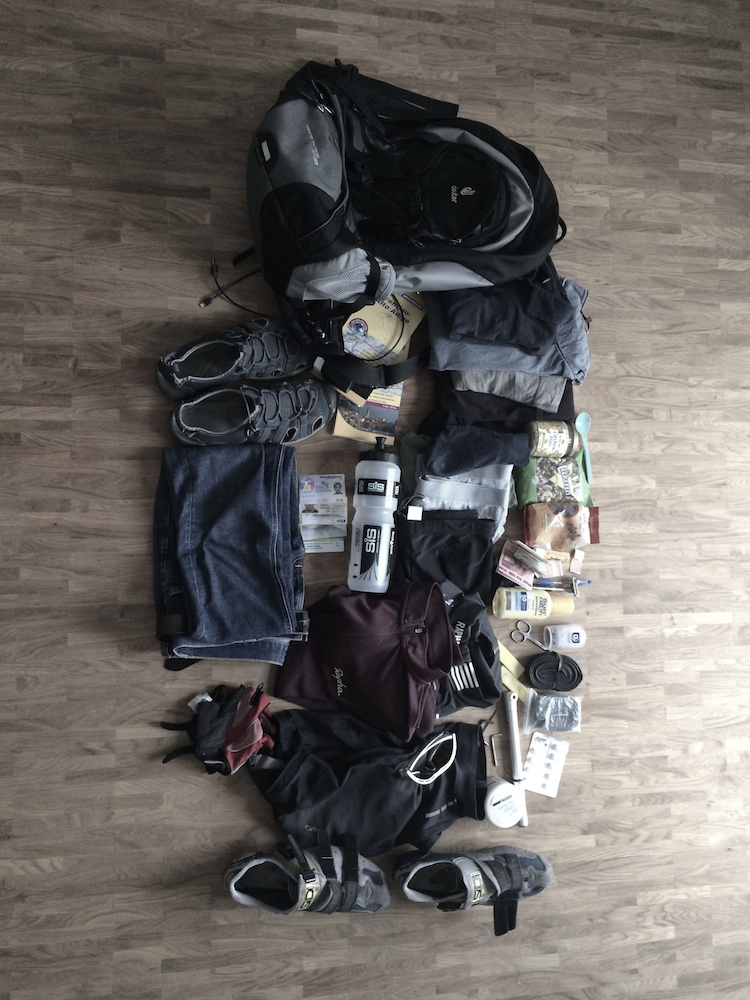
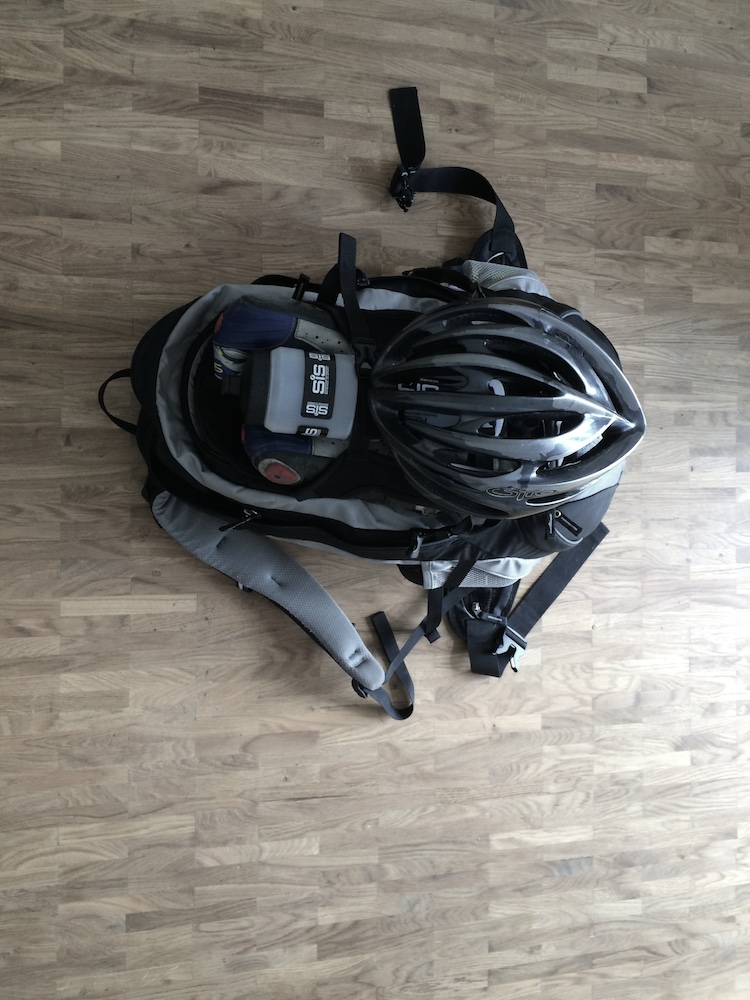
My trusted companion - Deuter's Transalpine backpack (32 EL).